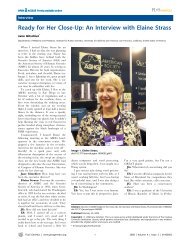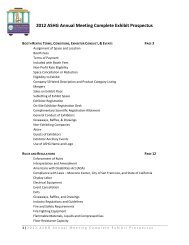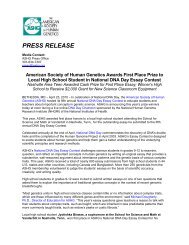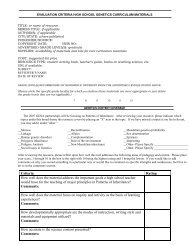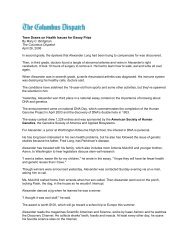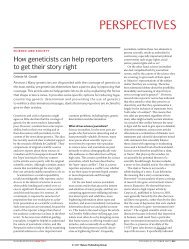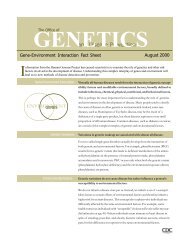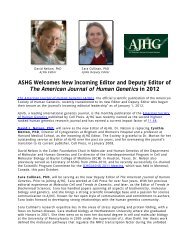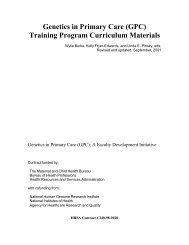ASHG Statement on Professional Disclosure of Familial Genetic ...
ASHG Statement on Professional Disclosure of Familial Genetic ...
ASHG Statement on Professional Disclosure of Familial Genetic ...
You also want an ePaper? Increase the reach of your titles
YUMPU automatically turns print PDFs into web optimized ePapers that Google loves.
<str<strong>on</strong>g>ASHG</str<strong>on</strong>g> Subcommittee <strong>on</strong> <strong>Familial</strong> <strong>Disclosure</strong>: <str<strong>on</strong>g>ASHG</str<strong>on</strong>g> <str<strong>on</strong>g>Statement</str<strong>on</strong>g> 475<br />
familial implicati<strong>on</strong>s, both prior to genetic testing and<br />
again if the patient refuses to communicate results, is<br />
paramount. It is presumed that most patients, provided<br />
with the proper informati<strong>on</strong>, will inform their relatives<br />
<strong>of</strong> potential risks so that early m<strong>on</strong>itoring, detecti<strong>on</strong>,<br />
and treatment are available to them.<br />
II. Background<br />
A. Ethical Frameworks for <strong>Disclosure</strong> <strong>of</strong> Otherwise<br />
C<strong>on</strong>fidential Informati<strong>on</strong><br />
There are four ethical positi<strong>on</strong>s regarding a healthcare<br />
pr<strong>of</strong>essi<strong>on</strong>al’s duty or privilege to warn at-risk relatives<br />
about genetic informati<strong>on</strong>. In the first paradigm,<br />
c<strong>on</strong>fidentiality is absolute, and all medical informati<strong>on</strong><br />
is strictly private. Although the health-care pr<strong>of</strong>essi<strong>on</strong>al<br />
may inform the patient about implicati<strong>on</strong>s for at-risk<br />
relatives, c<strong>on</strong>fidentiality prevents the health-care pr<strong>of</strong>essi<strong>on</strong>al<br />
from disclosing any genetic informati<strong>on</strong> to relatives;<br />
the health-care pr<strong>of</strong>essi<strong>on</strong>al has a duty not to<br />
breach c<strong>on</strong>fidentiality. From this viewpoint, it would be<br />
unethical to do so.<br />
Alternatively, the President’s Commissi<strong>on</strong> for the<br />
Study <strong>of</strong> Ethical Problems in Medicine and Biomedical<br />
and Behavioral Research (1983) proposed that healthcare–pr<strong>of</strong>essi<strong>on</strong>al<br />
disclosure to at-risk family members<br />
should take place <strong>on</strong>ly when (1) reas<strong>on</strong>able efforts to<br />
elicit voluntary c<strong>on</strong>sent to disclosure have failed; (2)<br />
there is a high probability that harm will occur if the<br />
informati<strong>on</strong> is withheld, and the disclosed informati<strong>on</strong><br />
will actually be used to avert harm; (3) the harm that<br />
would result to identifiable individuals would be serious;<br />
and (4) appropriate precauti<strong>on</strong>s are taken to ensure that<br />
<strong>on</strong>ly the genetic informati<strong>on</strong> needed for diagnosis and/<br />
or treatment <strong>of</strong> the disease in questi<strong>on</strong> is disclosed. These<br />
ethical guidelines do not imply a legal duty to warn; they<br />
simply set out circumstances in which the commissi<strong>on</strong><br />
believes it would be permissible to do so. The Institute<br />
<strong>of</strong> Medicine Committee (1994), in its report <strong>on</strong> the assessment<br />
<strong>of</strong> genetic risks, adopted similar language.<br />
A third possible approach involves warning the patient,<br />
before genetic testing, about the circumstances that<br />
would result in disclosure <strong>of</strong> genetic informati<strong>on</strong> to other<br />
family members, regardless <strong>of</strong> the patient’s intenti<strong>on</strong>s to<br />
disclose (Macklin 1992). In this way, arguably, the<br />
health-care pr<strong>of</strong>essi<strong>on</strong>al–patient relati<strong>on</strong>ship would not<br />
be jeopardized, as l<strong>on</strong>g as the health-care pr<strong>of</strong>essi<strong>on</strong>al<br />
assures the patient <strong>of</strong> the presumpti<strong>on</strong> <strong>of</strong> c<strong>on</strong>fidentiality<br />
and outlines the excepti<strong>on</strong>s to that presumpti<strong>on</strong>, prior<br />
to testing.<br />
Finally, the duty to warn could be c<strong>on</strong>sidered an ethical<br />
duty that might eventually become obligatory rather<br />
than permissive. Indeed, absence <strong>of</strong> explicit legal regulati<strong>on</strong>s<br />
does not translate into an absence <strong>of</strong> duty. An<br />
ethical duty can become a pr<strong>of</strong>essi<strong>on</strong>al norm <strong>of</strong> practice,<br />
and it may become the legal standard, as l<strong>on</strong>g as there<br />
are no important countervailing policy issues.<br />
B. The Duty to Warn under Law<br />
Statutes and legislati<strong>on</strong>, which protect the c<strong>on</strong>fidentiality<br />
<strong>of</strong> medical/genetic informati<strong>on</strong> in general, permit<br />
health-care pr<strong>of</strong>essi<strong>on</strong>als to disclose, in excepti<strong>on</strong>al<br />
cases, otherwise c<strong>on</strong>fidential informati<strong>on</strong>, without incurring<br />
liability. Physicians are required, <strong>on</strong> the basis <strong>of</strong><br />
public-policy interests, to report, to the appropriate authorities,<br />
communicable diseases, gunshot and other<br />
wounds, and evidence <strong>of</strong> child abuse and neglect.<br />
U.S. case law dealing with the general duty to warn<br />
identifiable third parties <strong>of</strong> a threat <strong>of</strong> violence (Taras<strong>of</strong>f<br />
v. Regents <strong>of</strong> the University <strong>of</strong> California, 551 P. 2d 334<br />
[CA 1976] [en banc]) found that a duty to warn is likely<br />
to exist if (1) the physician has a special relati<strong>on</strong>ship<br />
with either the pers<strong>on</strong> who may cause the harm or the<br />
potential victim, (2) the potential victim or pers<strong>on</strong> at<br />
risk is identifiable, and (3) the harm to the victim is<br />
foreseeable and serious. Such a duty has been distinguished<br />
from a possible duty to warn at-risk relatives<br />
about potential genetic risk, ins<strong>of</strong>ar as it is the patient’s<br />
acti<strong>on</strong>s that are likely to harm others in the former case,<br />
whereas in the latter case the patient is not putting relatives<br />
at risk by simply carrying the gene mutati<strong>on</strong>—the<br />
relatives already either have or do not have the mutati<strong>on</strong><br />
(Suter 1993; Park and Dickens 1995)).<br />
More specifically, a health-care pr<strong>of</strong>essi<strong>on</strong>al’s duty to<br />
warn in the c<strong>on</strong>text <strong>of</strong> genetic informati<strong>on</strong> was recently<br />
c<strong>on</strong>sidered by two U.S. courts. These cases may indicate<br />
an increasing trend toward disclosure: physicians were<br />
held to a duty to warn patients about familial implicati<strong>on</strong>s<br />
(Pate v. Threkel, 661 So. 2d 278 [FL 1995]),<br />
and, further, they were held to a duty to warn relatives<br />
known to be at risk (Safer v. Estate <strong>of</strong> Pack, 677 A 2d<br />
1188 [NJ Super A.D. 1996]), irrespective <strong>of</strong> potential<br />
c<strong>on</strong>flicts between the duty to warn and the obligati<strong>on</strong><br />
to protect c<strong>on</strong>fidentiality.<br />
C. Internati<strong>on</strong>al Trends and Positi<strong>on</strong>s<br />
Although the majority <strong>of</strong> foreign jurisdicti<strong>on</strong>s (e.g.,<br />
World Medical Associati<strong>on</strong>, World Health Organizati<strong>on</strong>,<br />
Council <strong>of</strong> Europe, Nuffield Council <strong>on</strong> Bioethics,<br />
Health Council <strong>of</strong> the Netherlands, and Privacy Commissi<strong>on</strong>er<br />
<strong>of</strong> Australia) maintain that c<strong>on</strong>fidentiality<br />
must be ensured and protected, the majority are also in<br />
favor <strong>of</strong> limited disclosure <strong>of</strong> genetic test results (without<br />
the c<strong>on</strong>sent <strong>of</strong> the patient) in cases where the harm to<br />
at-risk relatives is grave and imminent and where the<br />
disclosure <strong>of</strong> informati<strong>on</strong> could result in effective inter-



